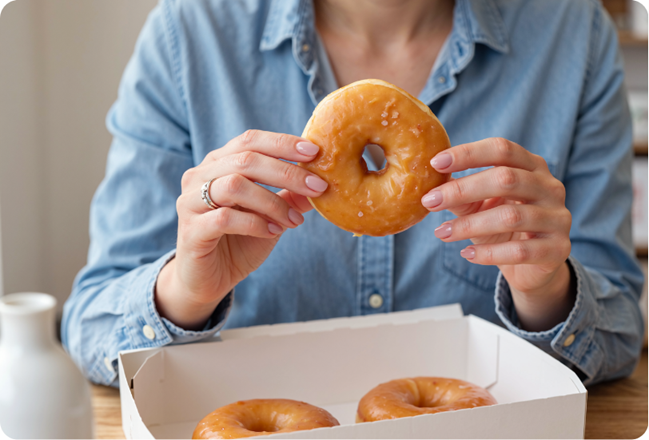Table of Contents
- Why Do We Get Food Cravings?
- The Nervous System–Stress Connection
- Stress and Food: Why Cortisol Makes You Crave Sugar
- The Cycle of Stress and Cravings
- Cravings and Women’s Health
- Nervous System Regulation: The Missing Piece
- Breathwork: A Science-Backed Tool to Reduce Cravings
- Practical Tips to Manage Stress-Driven Cravings
- Long-Term Benefits of Nervous System Regulation
- Restore Balance
- FAQs
We’ve all been there: standing in front of the fridge late at night or reaching for the office candy jar after a stressful day. Food cravings can feel impossible to resist, especially when stress is high. But what if these cravings aren’t about willpower at all? What if they’re your nervous system sending signals about imbalance, safety, and survival?
At Seesaw Health, we explore the connection between stress, the nervous system, and everyday behaviors like food cravings. Understanding this relationship is the first step toward breaking free from stress-driven eating patterns and supporting your body in healthier, sustainable ways.
Why Do We Get Food Cravings?
Food cravings are sudden, intense desires for specific foods—often sugary, salty, or fatty. Unlike regular hunger, cravings are more emotional and urgent. They’re driven by a combination of:
- Brain chemistry (neurotransmitters like dopamine and serotonin)
- Hormonal changes (cortisol, insulin, ghrelin, leptin)
- Emotional states (stress, sadness, boredom, or even happiness)
- Learned associations (comfort foods tied to childhood or positive memories)
While cravings might feel random, research shows they often surface during times of stress. That’s where the nervous system comes in.
The Nervous System–Stress Connection
Your nervous system has two main branches that control how your body responds to life:
- Sympathetic nervous system (SNS): Activates “fight or flight.” Increases heart rate, blood pressure, and stress hormones like cortisol.
- Parasympathetic nervous system (PNS): Activates “rest and digest.” Helps calm the body, lowers stress hormones, and supports digestion.
When you’re under constant pressure—tight deadlines, juggling family demands, or navigating major life changes—your sympathetic nervous system stays switched on. This stress response increases cortisol levels, which directly impacts your appetite and food preferences.
Stress and Food: Why Cortisol Makes You Crave Sugar
Cortisol, the primary stress hormone, plays a huge role in food cravings. Here’s how:
- Increases blood sugar demand: Your body wants quick energy (glucose) to deal with perceived threats.
- Boosts appetite: Cortisol stimulates hunger and reduces satiety signals, making it harder to feel full.
- Alters taste perception: Stress shifts your preference toward highly palatable foods—sweet, salty, fatty—which provide fast comfort.
- Rewards brain pathways: Eating these foods triggers dopamine release, reinforcing the stress-craving cycle.
This explains why, after a stressful meeting or an emotionally draining day, you might find yourself craving chips, chocolate, or ice cream—not a salad.
The Cycle of Stress and Cravings
Here’s what often happens:
- Stress kicks in → sympathetic nervous system activates.
- Cortisol rises → appetite increases, cravings surface.
- You reach for comfort foods → quick dopamine release brings temporary relief.
- Blood sugar spikes, then crashes → fatigue, irritability, and more cravings.
- Stress persists → cycle repeats, often leading to overeating or emotional eating.
Over time, this pattern can affect weight, mood, hormonal balance, and even your relationship with food.
Cravings and Women’s Health
For women, stress-related cravings can feel even more intense due to natural hormonal fluctuations. During the luteal phase of the menstrual cycle (the week or so before menstruation), drops in estrogen and rises in progesterone can enhance cravings for carbohydrate-rich foods. Add stress on top of that, and cravings can double in intensity.
This makes nervous system regulation even more important for women who want to feel more in control of their food choices and overall wellbeing.
Nervous System Regulation: The Missing Piece
Most advice around cravings focuses on willpower or diet hacks, avoiding certain foods, chewing gum, or drinking water when cravings strike. While these can help short-term, they don’t address the root cause: a dysregulated nervous system under stress.
When you regulate your nervous system, you:
- Lower cortisol levels
- Reduce “fight or flight” activation
- Improve digestion and metabolism
- Restore balance between hunger and satiety hormones
- Break the stress-craving cycle
This is where breathwork, mindfulness, and self-regulation practices make a measurable difference.
Breathwork: A Science-Backed Tool to Reduce Cravings
Breathing might seem too simple to impact cravings, but the science is clear: your breath is the fastest way to shift your nervous system.
When you practice slow, intentional breathing at the right frequency, you activate the parasympathetic nervous system, reducing cortisol and calming the brain’s stress circuits. This helps:
- Lower emotional reactivity to cravings
- Reduce impulsive eating behaviors
- Reconnect with true hunger and fullness signals
- Create space for intentional food choices instead of automatic ones
At Seesaw Health, our Egg biosensor helps women discover their body’s optimal breathing rhythm and guides them through breathwork designed to bring the nervous system back into balance. This real-time feedback empowers you to manage stress before it drives unhealthy cravings.
Practical Tips to Manage Stress-Driven Cravings
Here are strategies you can start using today:
1. Pause and Breathe
Next time a craving hits, take 60–90 seconds to breathe deeply and slowly. Inhale through your nose, exhale longer through your mouth. This activates your parasympathetic system and can reduce the urgency of the craving.
2. Check In with Your Body
Ask yourself: Am I truly hungry, or am I stressed, tired, or bored? Often cravings are signals of unmet needs (rest, comfort, connection) rather than hunger.
3. Nourish with Balanced Meals
Eating meals rich in protein, fiber, and healthy fats helps stabilize blood sugar, reducing spikes and crashes that intensify cravings.
4. Create Stress Outlets
Build daily routines that support nervous system balance—walks in nature, journaling, yoga, or guided breathwork sessions.
5. Reframe “Comfort Foods”
Comfort doesn’t have to come from cookies or chips. Warm herbal tea, a soothing playlist, or a mindful break can signal safety and comfort to your nervous system without food.
Long-Term Benefits of Nervous System Regulation
When you consistently practice nervous system regulation, cravings naturally lose their grip. Benefits include:
- More consistent energy throughout the day
- Improved mood and emotional resilience
- Healthier relationship with food
- Better digestion and hormone balance
- Greater confidence in handling stress without turning to food
This isn’t about perfection, it’s about giving your body the tools to feel safe, balanced, and supported.
Restore Balance
Food cravings are not a sign of weakness, they’re a sign your body and nervous system are asking for support. By understanding how stress and the nervous system drive cravings, you can stop blaming yourself and start using tools that restore balance.
At Seesaw Health, we believe women deserve science-backed, practical tools to manage stress and reclaim control over their health. Whether it’s through our biosensor technology or personalized breathwork guidance, our mission is to help you regulate your nervous system and live with more balance, less stress, and fewer cravings.
Because when your nervous system feels safe, your relationship with food—and with yourself—transforms.
FAQs
How does the nervous system influence food cravings?
Your nervous system plays a key role in regulating hunger and cravings. When your sympathetic nervous system (fight-or-flight mode) is activated by stress, it triggers the release of cortisol, which can increase appetite and cravings for high-sugar, high-fat foods. Conversely, activating the parasympathetic nervous system (rest-and-digest mode) helps calm these cravings and restore appetite balance.
Why do I crave more food during the luteal phase of my menstrual cycle?
During the luteal phase, which occurs after ovulation and before menstruation, hormonal changes play a significant role in increasing appetite. Progesterone levels rise, which can stimulate appetite and increase cravings for carbohydrate-rich foods. Additionally, insulin sensitivity decreases during this phase, leading to increased hunger and a preference for sweet and high-carbohydrate foods
Why do cravings feel stronger when I’m stressed?
Stress activates your body’s “fight-or-flight” response, increasing cortisol levels. Elevated cortisol not only stimulates hunger but also influences brain reward pathways, making highly palatable foods (like sweets or salty snacks) feel more rewarding. This is why cravings often intensify during stressful periods.
Are food cravings a sign of poor self-control?
Not at all. Cravings are often your body’s response to physiological stress signals and nervous system imbalances, rather than a lack of willpower. Understanding the connection between stress, cortisol, and nervous system activation can help you respond to cravings with strategies that support balance rather than restriction.




